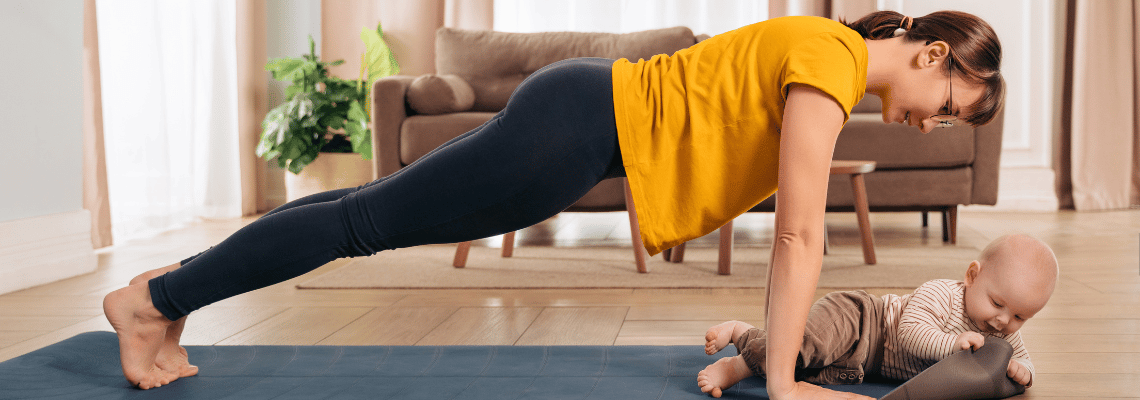
When it comes to postpartum exercise, the internet is laden with information. Unfortunately, much of this information is contradictory or even confusing for new mothers. Here, we aim to provide an in-depth guide to postpartum exercise to discuss when it is safe to start working out again after giving birth and the best exercises to do in each postpartum stage.
In general, when it comes to standard no issue, labor and delivery, it is typically safe to start exercising again six weeks after giving birth, although this may vary depending on specific circumstances. Women who have had a caesarean section (C-section), may need to wait a little longer before starting to exercise, to ensure proper recovery. For those mothers hoping to start exercising sooner than the six-week mark, listening to doctor’s recommendations and the body can ensure effort is not overly exerting and proper recovery can continue to take place if needed.
Tips for Postpartum Exercise
For those eager to start exercising sooner than six weeks post-delivery, there are some low-impact activities that can be done, such as walking or gentle stretching. One bit of invaluable advice is to listen to your body to ensure the body is not being pushed too hard or before it is ready.
Beginning with gentle exercises and gradually increasing the intensity can ease the body back into movement and range of motion and limit the risk of injury. Ensuring mother’s body is fully healed from any vaginal tearing or episiotomy before starting to exercise again is crucial for proper recovery. Thus, it is imperative to check with a doctor or midwife prior to resuming physical activity.
Once the six- or eight-week mark has been achieved, gradually ramping up activity levels can be beneficial and possible. For women who were active before pregnancy, it is likely that they can resume previous workout routines, although they may need to modify it slightly, or build up to their former routines. For women who were relatively inactive pre-pregnancy, it’s best to start slow and build up gradually.
In general, some specific exercises are particularly helpful in the postpartum period, and can even aid in postpartum recovery. These include pelvic floor exercises, which help to support the bladder and prevent urinary incontinence, and abdominal exercises, which can help heal the stomach muscles, repair abdominal separation, or diastasis recti, and improve posture.
Some of the simplest, yet beneficial exercises to perform postpartum can be found below.
Pelvic Floor Exercises
 Pelvic floor-focused postpartum exercises can generally be started as soon as you feel ready after giving birth, even if you have had a C-section. They can be done anytime, anywhere; sitting at your desk, watching TV, or even taking a bath. To do a simple pelvic floor exercise, squeeze the muscles around the vagina and anus as if trying to stop the flow of urine. Hold this simple squeeze for a count of three, then relax for a count of three. Repeat these holds ten times, and repeat as often as desired throughout the day.
Pelvic floor-focused postpartum exercises can generally be started as soon as you feel ready after giving birth, even if you have had a C-section. They can be done anytime, anywhere; sitting at your desk, watching TV, or even taking a bath. To do a simple pelvic floor exercise, squeeze the muscles around the vagina and anus as if trying to stop the flow of urine. Hold this simple squeeze for a count of three, then relax for a count of three. Repeat these holds ten times, and repeat as often as desired throughout the day.
To read more about Pregnancy and Your Pelvic Floor, click here.
Abdominal Postpartum Exercise
Abdominal exercises can be started once stitches have healed, when applicable, and your doctor or midwife has cleared you to start exercising again. These types of exercises should be done slowly and carefully until strength and endurance can be built up again.
Rather than jumping straight into sets of 20 crunches right off the bat, a good starting point for building back abdominal strength is to focus on the abs and core or the body during daily activities. Throughout the day, focus on pulling core muscles inward, not to be confused with sucking the stomach in.
Focus on pulling these abdominal muscles inward multiple times throughout the day, inhaling and exhaling deeply for 30 second holds.
For additional benefits, especially when healing conditions such as diastasis recti, practice deep abdominal breathing and active breaths. Take slow, deep breaths in filling the abdominal cavity, expanding through your ribcage and sending air down to your pelvic floor.
On a slow exhale, “zip up” your pelvic floor and abdominal muscles using the focus and engagement listed above. These muscles should be engaging simultaneously, and strengthening as a team. Repeat for two to three minutes.
For additional Abdominal Breathing Exercises for Diastasis Recti Recovery, click here.
As you start to feel stronger, you can increase the number of repetitions or add in more challenging exercises such as curl-ups, bridges, or planks as you work toward your new postpartum fitness routine.
A simple abdominal exercise is a “curl-up.” For this exercise, lie on your back on the floor with your knees bent and feet flat on the ground. Put your hands behind your head, keeping your elbows wide open. Use your stomach muscles to lift your head and shoulders slowly off the ground, curling upward, but securely planting the lower back on ground the entire time. Once the upper body is slightly lifted, hold for a count of five, then slowly lower back down rolling gently through the back, shoulders and neck. Repeat up to ten times.
For these ab busting moves, start in a push-up position, with your hands directly under your shoulders and your feet hip-width apart. Bend your elbows and lower yourself so your forearms are flat on the ground. Keep your back straight, hold this position for a count of five, and lower your back to the ground. Repeat ten times.
As you get stronger, you can hold the plank for longer or add in side planks: From the push-up position, rotate your body so that one forearm is resting on the ground and you are balancing on the other arm and the side of your foot. Hold for a count of five, then lower back down to the starting position and repeat on the other side.
Lower Body Exercises
While a majority of the focus postpartum is placed on toning and healing abdominal muscles, lower body exercises are a main area that should not be neglected.
Instead of stepping forward into a traditional lunge, give your knees and feet a bit of relief, while still working your legs and glutes.
Start with your feet planted firmly, hip width apart and take one foot and step backward into a mid-range lunge. Hold this position, bracing yourself against a wall or using a chair for additional balance and slowly pulse into the back glute. After 30 seconds of small and controlled pulses, step forward into your starting position and repeat, stepping back with the opposite leg.
For this exercise, lie on your back with your knees bent and feet flat on the floor, about hip-width apart. Contract the abs, and slowly lift your hips off the ground, keeping your shoulders and upper back in contact with the floor. Hold for a count of five, then slowly lower back down. Repeat ten times.
As you get stronger, you can hold the bridge for longer or add in a single-leg lift: As you lift your hips off the ground, extend one leg straight up towards the ceiling. Hold for a count of five, then lower back down and repeat with the other leg. This exercise helps with both core strength and stability and is especially helpful when looking to repair abdominal separation.
For additional Exercises to Help Repair Abdominal Separation, click here.
Upper Body Exercises
Additional exercises that can be done to build up to a postpartum fitness routine include a few that help build up arm and back strength, which are great for building the strength needed to carry around a new baby and all the gear.
This provides benefits of a traditional push up but also helps target the abs and upper back muscles without too much strain. To achieve this exercise, begin on all fours, kneeling on the floor or a may and placing your hands approximately three-feet in front of the knees with thumbs and index fingers barley touching and forming a triangle.
Your arms should be straight, head down and back slightly arched upward. To do a push up, keep your knees firmly on the ground, and shift your weight forward on to your hands, as you do so, bend your arms and bring your nose toward the triangle made by your hands. Push back up, rocking your weight from your hands back to your knees as you straighten your arms. Repeat this move, 10 to 15 times.
Using a light weight dumbbell or bottle of water in each hand, palms facing the body. Bend over at about a 45-degree angle, keeping your back straight. Slowly and steadily, bend your arms and lift the weights up close to the body until your arms are at or just below shoulder and back height. Slowly lower and repeat up to 10 times, staying bent over and engaging the abdominal muscles for the whole set.
Breastfeeding, and carrying a new baby around can take a toll on the neck muscles, so during postpartum, it is important to not overlook these muscles when it comes to strengthening and stretching.
Gently roll your neck forward and let the weight of your head pull your neck and upper back into an easy stretch. Hold this stretch for five to 10 seconds.
Slowly lift your head and lower your right ear toward your right shoulder, again taking care to be gentle in your movements. Let it rest there for five to 10 seconds before lifting your head and repeating this stretch on the left side.
After having a baby, giving your body time to recover before starting or resuming an exercise routine is important. Once your doctor or midwife has cleared you, a few specific exercises can help heal your stomach muscles, improve your posture and help you alleviate any aches and pains from carrying a new baby. Remember to start slowly and gradually increase the intensity as you build strength and endurance. With a little patience and perseverance, you’ll be back to your pre-pregnancy self, or a new healthy you, in no time.


